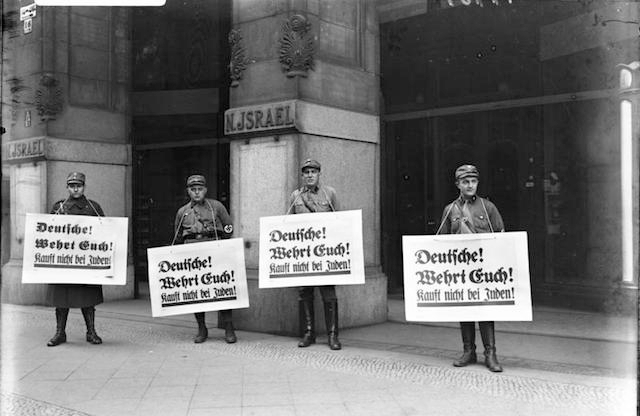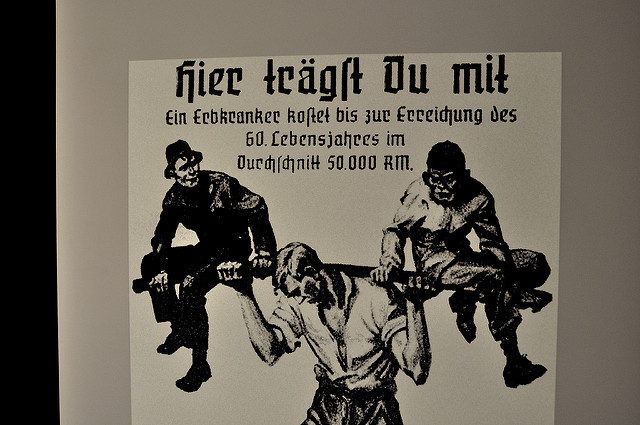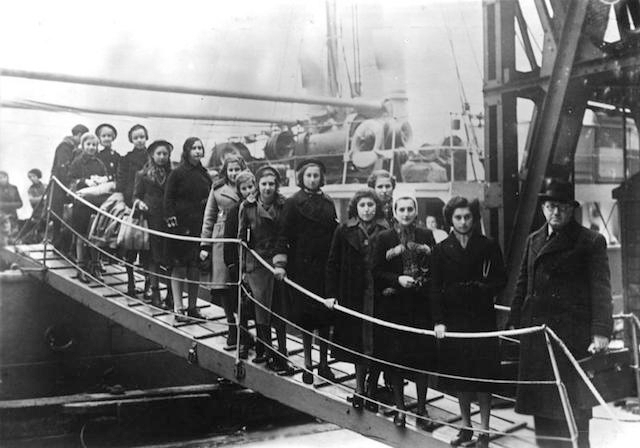What happened to Germans who were against Hitler
On January thirty, 1933, Adolf Hitler was named chancellor, the about powerful position in the German government, by the aged President Hindenburg, who hoped Hitler could lead the nation out of its grave political and economical crisis. Hitler was the leader of the correct-wing National Socialist German Workers Party (chosen "the Nazi Party" for brusque). It was, past 1933, 1 of the strongest parties in Frg, even though — reflecting the land's multiparty system — the Nazis had won simply a plurality of 33 per centum of the votes in the 1932 elections to the German parliament (Reichstag).
To read contemporary news accounts of the Holocaust and other Jewish events from 1917 on, search the JTA Archive.
Dismantling Federal republic of germany'southward Democracy

In one case in power, Hitler moved quickly to stop German language democracy. He convinced his cabinet to invoke emergency clauses of the constitution that permitted the break of private freedoms of press, oral communication, and assembly. Special security forces — the Gestapo, the Tempest Troopers (SA), and the SS — murdered or arrested leaders of opposition political parties (Communists, socialists, and liberals). The Enabling Act of March 23, 1933 — forced through the Reichstag already purged of many political opponents –gave dictatorial powers to Hitler.
READ: Jewish Reactions to the Enabling Act (March 24, 1933)
As well in 1933, the Nazis began to put into practice their racial ideology. The Nazis believed that the Germans were "racially superior" and that there was a struggle for survival between them and inferior races. They saw Jews, Roma (Gypsies), and the handicapped equally a serious biological threat to the purity of the "German (Aryan) Race," what they called the chief race.
Jews, who numbered about 525,000 in Deutschland (less than ane percent of the total population in 1933) were the principal target of Nazi hatred. The Nazis identified Jews as a race and defined this race as "inferior." They also spewed hate-mongering propaganda that unfairly blamed Jews for Germany's economic depression and the state's defeat in Globe War I (1914-1918).
Nuremberg Laws, Property Seizures and Kristallnacht
In 1933, new German laws forced Jews out of their civil service jobs, academy and law court positions, and other areas of public life. In Apr 1933, laws proclaimed at Nuremberg fabricated Jews second-class citizens. These Nuremberg Laws divers Jews, not by their religion or by how they wanted to identify themselves, just by the religious affiliation of their grandparents. Between 1937 and 1939, new anti-Jewish regulations segregated Jews further and made daily life very difficult for them. Jews could not attend public schools; go to theaters, cinema, or vacation resorts; or reside or even walk in certain sections of German cities.
Too betwixt 1937 and 1939, Jews increasingly were forced from Deutschland's economic life. The Nazis either seized Jewish businesses and properties outright or forced Jews to sell them at bargain prices. In November 1938, the Nazis organized a riot (pogrom), known as Kristallnacht (the "Night of Broken Drinking glass"). This attack against German and Austrian Jews included the physical devastation of synagogues and Jewish-owned stores, the arrest of Jewish men, the vandalization of homes, and the murder of individuals.
Non-Jewish Targets of Persecution

Although Jews were the main target of Nazi hatred, the Nazis persecuted other groups they viewed as racially or genetically "junior." Nazi racial ideology was buttressed by scientists who advocated "selective breeding" (eugenics) to "improve" the homo race. Laws passed betwixt 1933 and 1935 aimed to reduce the future number of genetic "inferiors" through involuntary sterilization programs: 320,000 to 350,000 individuals judged physically or mentally handicapped were subjected to surgical or radiation procedures and so they could not accept children. Supporters of sterilization also argued that the handicapped encumbered the community with the costs of their care. Many of Germany'southward thirty,000 Roma (Gypsies) were also eventually sterilized and prohibited, forth with Blacks, from intermarrying with Germans. Nigh 500 children of mixed African-German language backgrounds were also sterilized. New laws combined traditional prejudices with the racism of the Nazis, which defined Roma by "race" and every bit "criminal and asocial."
Another upshot of Hitler'due south ruthless dictatorship in the 1930s was the abort of political opponents and merchandise unionists and others whom the Nazis labeled "undesirables" and "enemies of the state." Some 5,000 to 15,000 homosexuals were imprisoned in concentration camps; under the 1935 Nazi-revised criminal code, the mere denunciation of a man equally "homosexual" could result in arrest, trial, and confidence. Jehovah's Witnesses, who numbered at least 25,000 in Frg, were banned as an system as early as April 1933, because the beliefs of this religious group prohibited them from swearing any oath to the country or serving in the German war machine. Their literature was confiscated, and they lost their jobs, unemployment benefits, pensions, and all social welfare benefits. Many Witnesses were sent to prisons and concentration camps in Nazi Germany, and their children were sent to juvenile detention homes and orphanages.
Refugees With No Place to Go

Between 1933 and 1936, g of people, mostly political prisoners, were imprisoned in concentrations camps, while several thousand High german Roma were confined in special municipal camps. The kickoff systematic round-upwardly of High german and Austrian Jews occurred after Kristallnacht, when approximately 30,000 Jewish men were deported to Dachau and other concentration camps, and several hundred Jewish women were sent to local jails. The moving ridge of arrests in 1938 besides included several grand German language and Austrian Roma.
Between 1933 and 1939, about half of the German-Jewish population and more than than 2-thirds of Austrian Jews (1938-1939) fled Nazi persecution. They emigrated mainly to the United States, Palestine, elsewhere in Europe (where many would be later trapped by Nazi conquests during the war), Latin America, and Japanese-occupied Shanghai (which required no visas for entry). Jews who remained nether Nazi rule were either unwilling to uproot themselves or unable to obtain visas, sponsors in host countries, or funds for emigration. Most foreign countries, including the United States, Canada, Britain, and France, were unwilling to admit very large numbers of refugees.
Reprinted courtesy of the United states Holocaust Memorial Museum.
Source: https://www.myjewishlearning.com/article/1933-1939-early-stages-of-persecution/
0 Response to "What happened to Germans who were against Hitler"
Postar um comentário